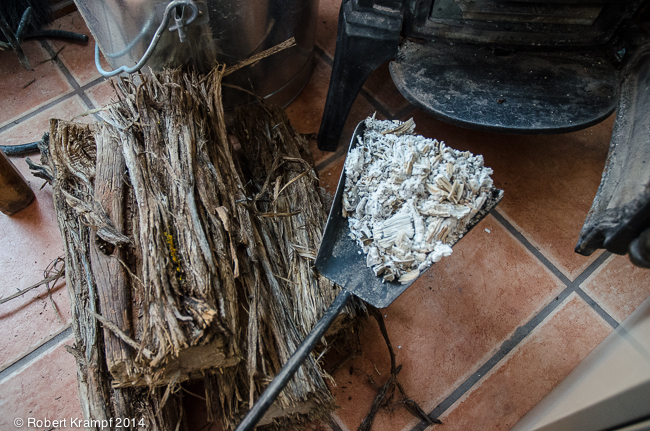
The wood in this pile will be reduced to this much ash when it is burned. What happens to the rest of the mass from the wood?
-
It was converted into energy.
No. Burning does not convert matter into energy. -
It evaporated.
No. While any moisture in the wood may have evaporated, wood itself does not evaporate. -
It was converted into water and carbon dioxide.
Yes! Burning converts the cellulose in wood into water vapor and carbon dioxide. The white ash that is left behind is made up of the minerals and nutrients which were taken in by the plant's roots. -
The matter is still there. It just got smaller.
No. If all of the matter was still there, the mass and weight would still be the same. The ash is much lighter than the wood, because the water vapor and carbon dioxide are now part of the air of the room. Still, if we could weigh all of the ash, water vapor, and carbon dioxide, the total mass would still be the same.
Click to see which state standards this question tests, and which of my videos, experiments, and other resources support that topic.
Florida
SC.4.P.8.3 Explore the Law of Conservation of Mass by demonstrating that the mass of a whole object is always the same as the sum of the masses of its parts.
| The Difference Between Weight and Mass | video, checked |
| Review Matter-2 | practice |
| Review Matter-6 | practice |
SC.8.P.9.1 Explore the Law of Conservation of Mass by demonstrating and concluding that mass is conserved when substances undergo physical and chemical changes.
| Making Butter | video, free, ClosedCaptions, Updated |
| Review Matter-2 | practice |
| Review Matter-6 | practice |
Utah
UT.5.I.1.a Compare the total weight of an object to the weight of its individual parts after being
disassembled.
| Review Matter-6 | practice |
UT.5.I.1.d Investigate chemical reactions in which the total weight of the materials before and after reaction is the same (e.g., cream and vinegar before and after mixing, borax and glue mixed to make a new substance).
| Changing Colors, part 1 | video |
| Changing Colors, part 2 | video |
| The Chemistry of Milk | video, ClosedCaptions, checked |
| Polymers and Slime | video, free, ClosedCaptions, checked |
| Review Matter-6 | practice |
UT.5.I.3.d Compare a physical change to a chemical change.
| Changing Colors, part 1 | video |
| Changing Colors, part 2 | video |
| The Chemistry of Milk | video, ClosedCaptions, checked |
| Making Butter | video, free, ClosedCaptions, Updated |
| Chemical and Physical Changes | video, ClosedCaptions, checked |
| Paper Petals | video, ClosedCaptions |
| Changing How We Look at Changing | text page, free |
| Review Matter-4 | practice |
UT.8.I.4.c Demonstrate that mass is conserved in a chemical reaction (e.g., mix two solutions that result in a color change or formation of a precipitate and weigh the solutions before and after mixing).
| Microscopes: Growing Crystals | video, free, learnalong, Updated |
| Growing Crystals Under the Microscope | video, free, learnalong, checked |
| Review Matter-6 | practice |
NGSS
5-PS1-2 Measure and graph quantities to provide evidence that regardless of the type of change that occurs when heating, cooling, or mixing substances, the total weight of matter is conserved.
| Making Butter | video, free, ClosedCaptions, Updated |
| The Difference Between Weight and Mass | video, checked |
| Ice Cream Science | video, checked |
| Chemical and Physical Changes | video, ClosedCaptions, checked |
| Air has Weight | text page |
| Review Matter-2 | practice |
| Review Matter-6 | practice |
MS-PS1-5 Develop and use a model to describe how the total number of atoms does not change in a chemical reaction and thus mass is conserved.
| Scientific Thinking and Creative Thought, part 3 | video, checked |
| Scientific Thinking and Creative Thought, part 2 | video, checked |
| Scientific Thinking and Creative Thought, part 1 | video, checked |
| Catalysts | video, ClosedCaptions, checked |
| Review Matter-6 | practice |
